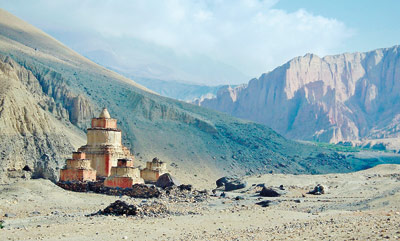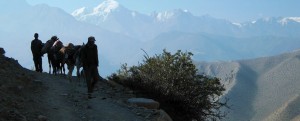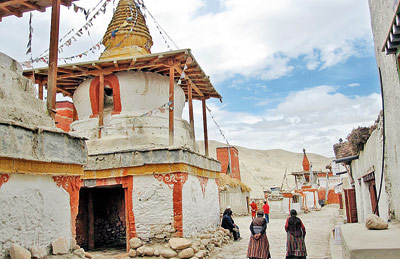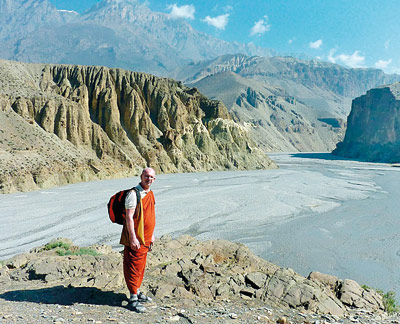A vision fast disappearing
Recently, I had the opportunity to visit Mustang in Nepal, one of the least known, least visited part of the Himalayas. Getting to Mustang is no easy thing.

A huge stupa in the high desert and (inset right) the Kali Gandak River running through the deepest canyon in the world
One must take a light plane to the end of the motorable road north of Pokkara and trek from there. There are no hotels or shops so one must carry everything on one’s back or hire porters to carry everything you need.
Between Ghorepani and Tikhedhunga the track consists of a three or four kilometre-long staircases, each stair being made of rough-hewn stones.
Ascending it is a lung-straining, heart-popping ordeal; trekking down it is murder on the knees. Along the way the track passes through neat villages, paddy fields and orchids. Climbing higher the track enters dark, damp forests of giant rhododendron, holly and deodars, all bedecked with moss, ferns and orchids.
Beautiful butterflies flit before the eyes, unfamiliar bird songs charm the ears and, if you are not watchful, voracious leeches attack the limbs.
At times the forest is so utterly still and silent I had to restrain myself from shouting, so as to fill it with at least some sound.
The track crosses numerous small streams and eventually runs besides a substantial river. By the time one gets to Taodapani, so-named for the hot spring on the edge of the village, the landscape has become more alpine, with open grassy meadows and pine forests and the mountains become steeper.
Eventually one gets to Jomsom. Here my companions and I met up with the three young men who were to be our porters.
Most of the buildings in Jomsom are are in the flat-roofed Tibetan style, the locals speak a dialect of Tibetan, and there are several Tibetan monasteries in the town. After a few preparations and delays we crossed the quaint cantilever bridge at the end of town and began our trek along the pebbly bed of the Kali Gandaki River towards Mustang.
Our ultimate destination in Mustang was to get to Lo Manthang, the walled town which is the capital of the region, about a 12 day trek.
Much of the track follows the Kali Kandaki River. Flowing as it does between the 8167 metre high Mt. Dhaulagiri and the 8091 metre high Mt. Annapurna, this river cuts what is believed to be the deepest gorge in the world, much deeper than the Grand Canyon.
No matter where you turn you are confronted by sheer cliffs, strangely eroded hummocks and on the horizon, soaring snow-capped mountains.
Wherever there is flat ground and water for irrigation there are small villages surrounded by green barley fields and orchards.
Sometimes at lonely places far from habitation one sees stupas or so-called mani walls, walls made out of hundreds of thousands of stones with the mantra Om Mani Padme Hum carved on them, reminders that this is a Buddhist land.
While evoking interest and sometimes even awe, none of the vistas is enough to make you forget just how difficult the trek to Lo Manthang is.
Between Chele and Samar the path is almost vertical and seems to go on forever. The air, gradually becoming thinner as one gets higher, makes the trek even more arduous.
The ascent from Yamda to Syangboche makes the knees ache so much that when you reach the bottom you can hardly walk.
Another difficulty is the wind, sometimes howling, at other times full of grit and dust, which usually starts blowing after midday.
Buddhist monks’ robes were not designed for windy places and mine was continually blowing off or filling with gusts like the sail of a ship, so as to force me sideways or blow me over.
This was very trying and added to the exhaustion. The landscape is so dry, rugged and sparse one wonders why anyone would want to live there, indeed how anyone can live there.
The land is capable of growing a few hardy crops but so dry that only irrigation makes agriculture possible. The height of the mountains means that rising clouds drop their rain long before they get to Mustang.
A brief but disconcerting experience was crossing the several suspension bridges. Each step you take makes the bridge wobble and if you look down you freeze with horror at just how far down it is.
I should mention that all these bridges are very sturdy, but your imagination keeps pushing this knowledge out of your mind.
The ruins of numerous forts throughout Mustang speak of its tumultuous history; petty lords vying with each other for power and invasions from neighbouring states.
By 1768 the Gurkhas had conquered and united most of what today is modern Nepal and then turned their eyes to Mustang. It seems they did not invade the kingdom but its king became a tributary of the Gurkha court, paying a yearly tribute while remaining independent in all but name.
In 1962 the Raja Abolition Act divested all Nepal’s minor rulers of their power, an exception being made for the king of Mustang.
After the Chinese invasion of Tibet in 1950 Mustang became the base for Tibetan freedom fighters organized and financed by Taiwan and the CIA.

The main street in Lo Manthang, the capital of Mustang
Eventually, Chinese threats to Nepal put an end to all that and the Nepalese government took full control of Mustang, ending any power the king had.
However, His Highness Jigme Dorje Palbar Bista is still regarded with great respect and I noticed pictures of him and his queen in most homes.
The people of Mustang are all Buddhists and nearly every village has a monastery near it. Other than the main temple in Lo Manthang and the monastery at Tsarang few of the religious establishments are particularly impressive or interesting.
Nonetheless, Buddhism’s influence is apparent in the friendly, good-natured demeanour of the people. While at Ghami I wandered into the temple to find the monks assembled and doing their puja.
Immediately the senior monk motioned another monk to find me a seat and as soon as I sat down a lady brought me fried bread and butter tea.
While I appreciated this hospitality I was not looking forward to sitting through one of those endless Tibetan pujas, or having to drink cup after cup of butter tea.
As it happens the puja only went for another 20 minutes and after the first tea they brought me tea with sugar in it rather than the usual salt.
As soon as the puja was finished I was invited to join the monks for a meal – rice, yogurt and what they called ‘grass’, some kind of vegetable.
One of the younger monks spoke good English and explained to me what was going on and he in turn translated all the questions the other monks asked me and my answers to them.
Soon the subject got to Theravada monks’ robes and I showed them the Sri Lankan way of putting on a robe. They were both amused and impressed.
Lo Manthang, the capital of Mustang is a bit what I imagine parts of London, Orleans or Frankfurt were like in the Middle Ages. It is also probably the only town in the world which still looks like what all towns in Tibet looked like before 1959.
Lo Munthang is enclosed by a wall with towers and a gate, its streets are dirty and narrow and the smell of animal dung hangs in the air.
The only open area is the small square in front of the king’s palace. The square and most of the streets are paved with large flagstones, although I was told this is a recent innovation.
Like a medieval European town or city the dominating buildings in Lo Manthang are religious – the 15th century Jampa Lhakhang, Chodey Gompa and Choprang Gompa.
The inner walls of the first of these are covered with paintings of extraordinary vibrancy and beauty, although they can hardly be seen in the dark. Situated here and there around the town and in the street leading to the main gate are clusters of stupas.
Early each morning I noticed people, mainly women, circumambulating the town with the characteristic Tibetan two steps one bow, a distance of about two or three kilometres. Clearly people are maintaining their traditional piety.
Walking through the streets one often has to make way for herds of goats or pack of mules and when the wind blows it whips up the dirt and the dust.
Although Lo Manthang is evocative of a time gone by and is fascinating to visit, I have no illusions that living there must have numerous disadvantages.
Singapore where I live, might be uninteresting, boring and familiar, but we have clean water, efficient garbage disposal, excellent health regulations, clean air and air conditioning.
But Lo Manthang certainly has something Singapore does not – atmosphere and a vision of a world that has disappeared almost everywhere.


